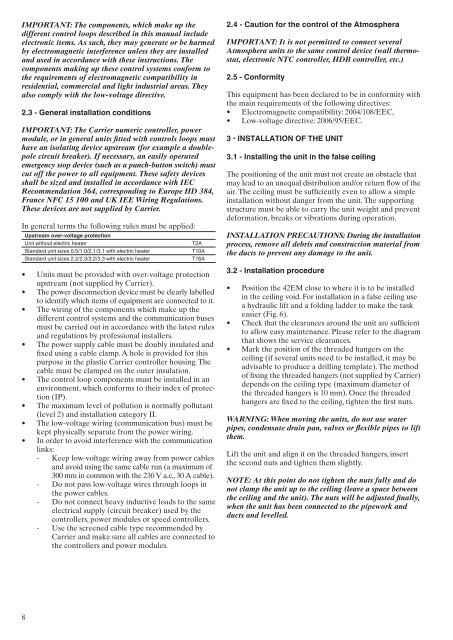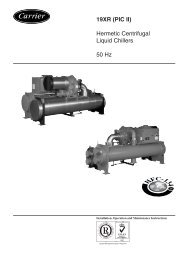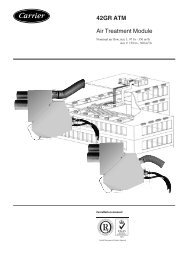EN DUCTED FAN COIL UNITS Installation instructions FR VENTILO ...
EN DUCTED FAN COIL UNITS Installation instructions FR VENTILO ...
EN DUCTED FAN COIL UNITS Installation instructions FR VENTILO ...
You also want an ePaper? Increase the reach of your titles
YUMPU automatically turns print PDFs into web optimized ePapers that Google loves.
IMPORTANT: The components, which make up the<br />
different control loops described in this manual include<br />
electronic items. As such, they may generate or be harmed<br />
by electromagnetic interference unless they are installed<br />
and used in accordance with these <strong>instructions</strong>. The<br />
components making up these control systems conform to<br />
the requirements of electromagnetic compatibility in<br />
residential, commercial and light industrial areas. They<br />
also comply with the low-voltage directive.<br />
2.3 - General installation conditions<br />
IMPORTANT: The Carrier numeric controller, power<br />
module, or in general units fitted with controls loops must<br />
have an isolating device upstream (for example a doublepole<br />
circuit breaker). If necessary, an easily operated<br />
emergency stop device (such as a punch-button switch) must<br />
cut off the power to all equipment. These safety devices<br />
shall be sized and installed in accordance with IEC<br />
Recommendation 364, corresponding to Europe HD 384,<br />
France NFC 15 100 and UK IEE Wiring Regulations.<br />
These devices are not supplied by Carrier.<br />
In general terms the following rules must be applied:<br />
Upstream over-voltage protection<br />
Unit without electric heater T2A<br />
Standard unit sizes 0.5/1.0/2.1/3.1 with electric heater T10A<br />
Standard unit sizes 2.2/2.3/3.2/3.3 with electric heater T16A<br />
• Units must be provided with over-voltage protection<br />
upstream (not supplied by Carrier).<br />
• The power disconnection device must be clearly labelled<br />
to identify which items of equipment are connected to it.<br />
• The wiring of the components which make up the<br />
different control systems and the communication buses<br />
must be carried out in accordance with the latest rules<br />
and regulations by professional installers.<br />
• The power supply cable must be doubly insulated and<br />
fixed using a cable clamp. A hole is provided for this<br />
purpose in the plastic Carrier controller housing. The<br />
cable must be clamped on the outer insulation.<br />
• The control loop components must be installed in an<br />
environment, which conforms to their index of protection<br />
(IP).<br />
• The maximum level of pollution is normally pollutant<br />
(level ) and installation category II.<br />
• The low-voltage wiring (communication bus) must be<br />
kept physically separate from the power wiring.<br />
• In order to avoid interference with the communication<br />
links:<br />
- Keep low-voltage wiring away from power cables<br />
and avoid using the same cable run (a maximum of<br />
300 mm in common with the 30 V a.c., 30 A cable).<br />
- Do not pass low-voltage wires through loops in<br />
the power cables.<br />
- Do not connect heavy inductive loads to the same<br />
electrical supply (circuit breaker) used by the<br />
controllers, power modules or speed controllers.<br />
- Use the screened cable type recommended by<br />
Carrier and make sure all cables are connected to<br />
the controllers and power modules.<br />
8<br />
2.4 - Caution for the control of the atmosphera<br />
IMPORTANT: It is not permitted to connect several<br />
Atmosphera units to the same control device (wall thermostat,<br />
electronic NTC controller, HDB controller, etc.)<br />
2.5 - Conformity<br />
This equipment has been declared to be in conformity with<br />
the main requirements of the following directives:<br />
• Electromagnetic compatibility: 004/108/EEC,<br />
• Low-voltage directive: 006/95/EEC.<br />
3 - INSTAllATION OF THE UNIT<br />
3.1 - installing the unit in the false ceiling<br />
The positioning of the unit must not create an obstacle that<br />
may lead to an unequal distribution and/or return flow of the<br />
air. The ceiling must be sufficiently even to allow a simple<br />
installation without danger from the unit. The supporting<br />
structure must be able to carry the unit weight and prevent<br />
deformation, breaks or vibrations during operation.<br />
INSTALLATION PRECAUTIONS: During the installation<br />
process, remove all debris and construction material from<br />
the ducts to prevent any damage to the unit.<br />
3.2 - installation procedure<br />
• Position the 4 EM close to where it is to be installed<br />
in the ceiling void. For installation in a false ceiling use<br />
a hydraulic lift and a folding ladder to make the task<br />
easier (Fig. 6).<br />
• Check that the clearances around the unit are sufficient<br />
to allow easy maintenance. Please refer to the diagram<br />
that shows the service clearances.<br />
• Mark the position of the threaded hangers on the<br />
ceiling (if several units need to be installed, it may be<br />
advisable to produce a drilling template). The method<br />
of fixing the threaded hangers (not supplied by Carrier)<br />
depends on the ceiling type (maximum diameter of<br />
the threaded hangers is 10 mm). Once the threaded<br />
hangers are fixed to the ceiling, tighten the first nuts.<br />
WARNING: When moving the units, do not use water<br />
pipes, condensate drain pan, valves or flexible pipes to lift<br />
them.<br />
Lift the unit and align it on the threaded hangers, insert<br />
the second nuts and tighten them slightly.<br />
NOTE: At this point do not tighten the nuts fully and do<br />
not clamp the unit up to the ceiling (leave a space between<br />
the ceiling and the unit). The nuts will be adjusted finally,<br />
when the unit has been connected to the pipework and<br />
ducts and levelled.




